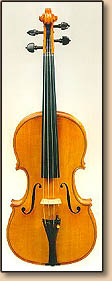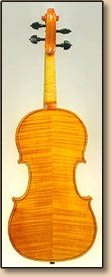Being the country of origin of the violin itself, the Italian school has a strong influence on the traditions in other countries. The most famous of the Italian schools is that from Cremona, whose influence upon violin making is unparalleled. Its founder was Andrea Amati (1525-1611). The influence of four generations of the Amati family upon many later violin makers has been considerable.
The strong influence of the Amatis is clear in the work of the most famous and greatest of all violin makers, Antonio Stradivarius (1644-1737). The tradition of the instruments of Stradivarius still lives on in instrument making today. His models have been extensively copied ever since the eighteenth century.
When I studied at the Leksand violin makers' school in Sweden, I became interested in the instruments of Stradivarius and the old Cremona masters. The instruments which I make are largely based on various Stradivarius models, mostly those of the early eighteenth century, and also the models of other Italian eighteenth century masters, such as Giuseppe Guarneri (1698-1744) and Giovanni Battista Guadagnini (1711-1786).
The earliest instruments of Stradivarius, dating from 1666, are grounded in the work of Nicolo Amati (1596-1684). During the 1680's Stradivarius followed the form of Amati's violins, but the shape was otherwise original. In the 1690's Stradivarius made a remarkable change in his instruments, when he increased the length of the body (the Long Pattern). The traditional length of 355mm was increased by 12mm, and other proportions of the body were also altered slightly. The instruments of this period of the production of Stradivarius may be considered more beautiful and stylish. In the 1700's Stardivarius returned to the earlier "normal" length. From 1700 to 1718 he built acoustically his best instruments, which are known as those of the "golden period".
The workshop of Stradivarius was productive, with about 1200 instruments being produced by the master or those under his supervision. About half of these have been preserved. Stradivarius has achieved the fame of a magician as a violin maker. His secret seems to lie simply in his carefulness and creativity. He constantly tried out new possibilities, and did not remain within the frame of the same models or styles. In addition to bowed string instruments he also made plucked stringed instruments, such as guitars and lutes. The making of other instruments too probably helped him to grasp other aspects of acoustics and instrument making, thus enabling him to use what he learned in making bowed string instruments.
Italy's three most famous violin maker families:
The Amati family
Andrea Amati(1505-1577), dates of birth and death vary with source
Antonio Amati (n.1540-1630), Andrea's son
Girolamo Amati (1561-1630), Andrea's son
Antonius Hieronymos Amati (1577-1628), Antonio's son
Niccolo Amati (1596-1684), Girolomos son
Hieronymos (Filius Nicolaus) (1649-1740), Niccolo's son
Don Nicolaus(1720-1745), Hieronymos' son
The Guarnerius family
Andrea Guarnerius (1626-1698)
Pietro Guarnerius(1655-1720), Andrea's son
Giuseppe Guarnerius (1666-1739), Andrea's son
Pietro Guarnerius (1695-1762), Giuseppe's son
Giuseppe (del Gesu) (1698-1744), Giuseppe's son
The Stradivarius family
Antonius Stradivarius (1644-1737)
Francesco Stradivarius (1671-1743), Antonio's son
Omobono Stradivarius (1679-1742), Antonio's son

Violin
made by Jussi Laasanen, 1997 (copy of Stradivarius)
